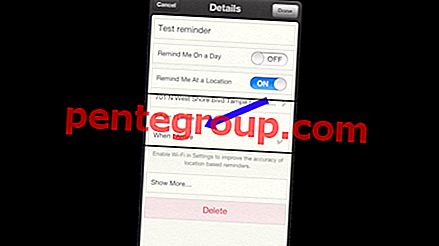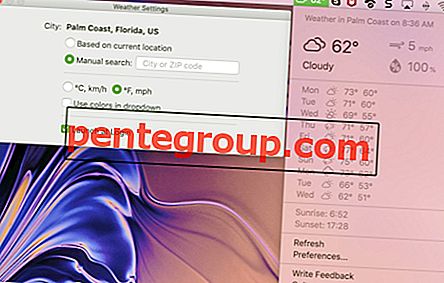Błąd iTunes 17 występuje głównie z powodu problemu z łącznością; szczególnie, gdy komputer nie może połączyć się z serwerami Apple lub iPhonem. Jest bardzo podobny do błędu iTunes 3194 i dlatego wymaga naprawy tych samych rozwiązań.
Błąd 17 może również pojawić się z powodu przestarzałej wersji iTunes i zbyt wrażliwego oprogramowania zabezpieczającego. Jeśli napotkałeś ten problem podczas aktualizacji urządzenia iOS i szukasz szybkich sposobów jego rozwiązania, skorzystaj z tych realnych rozwiązań.

Jak naprawić błąd iTunes 17
Szybkie porady:
- Odłącz urządzenie iOS od komputera → uruchom ponownie urządzenie → podłącz je ponownie do komputera i spróbuj zaktualizować ponownie.
- Jeśli masz inny dostępny, spróbuj go użyć do połączenia urządzenia z komputerem.
Sprawdź swoją sieć
Ponieważ mówimy o problemach z łącznością, problem leży w tym, że iTunes próbuje - bezskutecznie - połączyć i pobrać wymagany plik IPSW z serwera Apple. Nie musi to oznaczać, że sieć nie działa lub jest wadliwa, ale sprawdzenie jej pomaga.
Jeśli korzystasz z Wi-Fi, upewnij się, że jest stabilny. Jeśli możesz przełączyć się na sieć LAN, dopóki iTunes nie pobierze pliku, zrób to dla stabilnej sieci. Ale jeśli masz pewność, że Twoja sieć działa dobrze, przejdź do następnej wskazówki.
Tymczasowo usuń oprogramowanie zabezpieczające
Jeśli masz zainstalowane oprogramowanie zabezpieczające na swoim komputerze, sprawdź, czy nie uniemożliwia ono iTunes wykonywania jego zwykłych zadań. Może to zakłócać połączenie komputera z iTunes.
Dlatego spróbuj tymczasowo usunąć oprogramowanie zabezpieczające. Niektóre aplikacje bezpieczeństwa mogą nie zostać całkowicie odinstalowane. Dlatego będziesz musiał pobrać i uruchomić narzędzie do czyszczenia, aby je usunąć. Jeśli potrzebujesz dodatkowej pomocy, skontaktuj się z oprogramowaniem zabezpieczającym, dostawcą.
Zresetuj plik hostów
Plik Hosts jest używany przez system operacyjny do mapowania nazw hostów na adresy IP. Spróbuj go zresetować.
Zresetuj plik Hosts w systemie Windows
Krok 1. Po pierwsze otwórz Notatnik.
Krok 2. Teraz musisz skopiować następujący tekst. Następnie wklej go do pliku.
# Copyright (c) 1993-2006 Microsoft Corp. # # This is a sample HOSTS file used by Microsoft TCP/IP for Windows. # # This file contains the mappings of IP addresses to host names. Each # entry should be kept on an individual line. The IP address should # be placed in the first column followed by the corresponding host name. # The IP address and the host name should be separated by at least one # space. # # Additionally, comments (such as these) may be inserted on individual # lines or following the machine name denoted by a '#' symbol. # # For example: # # 102.54.94.97 rhino.acme.com # source server # 38.25.63.10 x.acme.com # x client host # localhost name resolution is handle within DNS itself. # 127.0.0.1 localhost # ::1 localhost
# Copyright (c) 1993-2006 Microsoft Corp. # # This is a sample HOSTS file used by Microsoft TCP/IP for Windows. # # This file contains the mappings of IP addresses to host names. Each # entry should be kept on an individual line. The IP address should # be placed in the first column followed by the corresponding host name. # The IP address and the host name should be separated by at least one # space. # # Additionally, comments (such as these) may be inserted on individual # lines or following the machine name denoted by a '#' symbol. # # For example: # # 102.54.94.97 rhino.acme.com # source server # 38.25.63.10 x.acme.com # x client host # localhost name resolution is handle within DNS itself. # 127.0.0.1 localhost # ::1 localhost
# Copyright (c) 1993-2006 Microsoft Corp. # # This is a sample HOSTS file used by Microsoft TCP/IP for Windows. # # This file contains the mappings of IP addresses to host names. Each # entry should be kept on an individual line. The IP address should # be placed in the first column followed by the corresponding host name. # The IP address and the host name should be separated by at least one # space. # # Additionally, comments (such as these) may be inserted on individual # lines or following the machine name denoted by a '#' symbol. # # For example: # # 102.54.94.97 rhino.acme.com # source server # 38.25.63.10 x.acme.com # x client host # localhost name resolution is handle within DNS itself. # 127.0.0.1 localhost # ::1 localhost
# Copyright (c) 1993-2006 Microsoft Corp. # # This is a sample HOSTS file used by Microsoft TCP/IP for Windows. # # This file contains the mappings of IP addresses to host names. Each # entry should be kept on an individual line. The IP address should # be placed in the first column followed by the corresponding host name. # The IP address and the host name should be separated by at least one # space. # # Additionally, comments (such as these) may be inserted on individual # lines or following the machine name denoted by a '#' symbol. # # For example: # # 102.54.94.97 rhino.acme.com # source server # 38.25.63.10 x.acme.com # x client host # localhost name resolution is handle within DNS itself. # 127.0.0.1 localhost # ::1 localhost
# Copyright (c) 1993-2006 Microsoft Corp. # # This is a sample HOSTS file used by Microsoft TCP/IP for Windows. # # This file contains the mappings of IP addresses to host names. Each # entry should be kept on an individual line. The IP address should # be placed in the first column followed by the corresponding host name. # The IP address and the host name should be separated by at least one # space. # # Additionally, comments (such as these) may be inserted on individual # lines or following the machine name denoted by a '#' symbol. # # For example: # # 102.54.94.97 rhino.acme.com # source server # 38.25.63.10 x.acme.com # x client host # localhost name resolution is handle within DNS itself. # 127.0.0.1 localhost # ::1 localhost
# Copyright (c) 1993-2006 Microsoft Corp. # # This is a sample HOSTS file used by Microsoft TCP/IP for Windows. # # This file contains the mappings of IP addresses to host names. Each # entry should be kept on an individual line. The IP address should # be placed in the first column followed by the corresponding host name. # The IP address and the host name should be separated by at least one # space. # # Additionally, comments (such as these) may be inserted on individual # lines or following the machine name denoted by a '#' symbol. # # For example: # # 102.54.94.97 rhino.acme.com # source server # 38.25.63.10 x.acme.com # x client host # localhost name resolution is handle within DNS itself. # 127.0.0.1 localhost # ::1 localhost
# Copyright (c) 1993-2006 Microsoft Corp. # # This is a sample HOSTS file used by Microsoft TCP/IP for Windows. # # This file contains the mappings of IP addresses to host names. Each # entry should be kept on an individual line. The IP address should # be placed in the first column followed by the corresponding host name. # The IP address and the host name should be separated by at least one # space. # # Additionally, comments (such as these) may be inserted on individual # lines or following the machine name denoted by a '#' symbol. # # For example: # # 102.54.94.97 rhino.acme.com # source server # 38.25.63.10 x.acme.com # x client host # localhost name resolution is handle within DNS itself. # 127.0.0.1 localhost # ::1 localhost
# Copyright (c) 1993-2006 Microsoft Corp. # # This is a sample HOSTS file used by Microsoft TCP/IP for Windows. # # This file contains the mappings of IP addresses to host names. Each # entry should be kept on an individual line. The IP address should # be placed in the first column followed by the corresponding host name. # The IP address and the host name should be separated by at least one # space. # # Additionally, comments (such as these) may be inserted on individual # lines or following the machine name denoted by a '#' symbol. # # For example: # # 102.54.94.97 rhino.acme.com # source server # 38.25.63.10 x.acme.com # x client host # localhost name resolution is handle within DNS itself. # 127.0.0.1 localhost # ::1 localhost
# Copyright (c) 1993-2006 Microsoft Corp. # # This is a sample HOSTS file used by Microsoft TCP/IP for Windows. # # This file contains the mappings of IP addresses to host names. Each # entry should be kept on an individual line. The IP address should # be placed in the first column followed by the corresponding host name. # The IP address and the host name should be separated by at least one # space. # # Additionally, comments (such as these) may be inserted on individual # lines or following the machine name denoted by a '#' symbol. # # For example: # # 102.54.94.97 rhino.acme.com # source server # 38.25.63.10 x.acme.com # x client host # localhost name resolution is handle within DNS itself. # 127.0.0.1 localhost # ::1 localhost
# Copyright (c) 1993-2006 Microsoft Corp. # # This is a sample HOSTS file used by Microsoft TCP/IP for Windows. # # This file contains the mappings of IP addresses to host names. Each # entry should be kept on an individual line. The IP address should # be placed in the first column followed by the corresponding host name. # The IP address and the host name should be separated by at least one # space. # # Additionally, comments (such as these) may be inserted on individual # lines or following the machine name denoted by a '#' symbol. # # For example: # # 102.54.94.97 rhino.acme.com # source server # 38.25.63.10 x.acme.com # x client host # localhost name resolution is handle within DNS itself. # 127.0.0.1 localhost # ::1 localhost
# Copyright (c) 1993-2006 Microsoft Corp. # # This is a sample HOSTS file used by Microsoft TCP/IP for Windows. # # This file contains the mappings of IP addresses to host names. Each # entry should be kept on an individual line. The IP address should # be placed in the first column followed by the corresponding host name. # The IP address and the host name should be separated by at least one # space. # # Additionally, comments (such as these) may be inserted on individual # lines or following the machine name denoted by a '#' symbol. # # For example: # # 102.54.94.97 rhino.acme.com # source server # 38.25.63.10 x.acme.com # x client host # localhost name resolution is handle within DNS itself. # 127.0.0.1 localhost # ::1 localhost
# Copyright (c) 1993-2006 Microsoft Corp. # # This is a sample HOSTS file used by Microsoft TCP/IP for Windows. # # This file contains the mappings of IP addresses to host names. Each # entry should be kept on an individual line. The IP address should # be placed in the first column followed by the corresponding host name. # The IP address and the host name should be separated by at least one # space. # # Additionally, comments (such as these) may be inserted on individual # lines or following the machine name denoted by a '#' symbol. # # For example: # # 102.54.94.97 rhino.acme.com # source server # 38.25.63.10 x.acme.com # x client host # localhost name resolution is handle within DNS itself. # 127.0.0.1 localhost # ::1 localhost
# Copyright (c) 1993-2006 Microsoft Corp. # # This is a sample HOSTS file used by Microsoft TCP/IP for Windows. # # This file contains the mappings of IP addresses to host names. Each # entry should be kept on an individual line. The IP address should # be placed in the first column followed by the corresponding host name. # The IP address and the host name should be separated by at least one # space. # # Additionally, comments (such as these) may be inserted on individual # lines or following the machine name denoted by a '#' symbol. # # For example: # # 102.54.94.97 rhino.acme.com # source server # 38.25.63.10 x.acme.com # x client host # localhost name resolution is handle within DNS itself. # 127.0.0.1 localhost # ::1 localhost
# Copyright (c) 1993-2006 Microsoft Corp. # # This is a sample HOSTS file used by Microsoft TCP/IP for Windows. # # This file contains the mappings of IP addresses to host names. Each # entry should be kept on an individual line. The IP address should # be placed in the first column followed by the corresponding host name. # The IP address and the host name should be separated by at least one # space. # # Additionally, comments (such as these) may be inserted on individual # lines or following the machine name denoted by a '#' symbol. # # For example: # # 102.54.94.97 rhino.acme.com # source server # 38.25.63.10 x.acme.com # x client host # localhost name resolution is handle within DNS itself. # 127.0.0.1 localhost # ::1 localhost
# Copyright (c) 1993-2006 Microsoft Corp. # # This is a sample HOSTS file used by Microsoft TCP/IP for Windows. # # This file contains the mappings of IP addresses to host names. Each # entry should be kept on an individual line. The IP address should # be placed in the first column followed by the corresponding host name. # The IP address and the host name should be separated by at least one # space. # # Additionally, comments (such as these) may be inserted on individual # lines or following the machine name denoted by a '#' symbol. # # For example: # # 102.54.94.97 rhino.acme.com # source server # 38.25.63.10 x.acme.com # x client host # localhost name resolution is handle within DNS itself. # 127.0.0.1 localhost # ::1 localhost
# Copyright (c) 1993-2006 Microsoft Corp. # # This is a sample HOSTS file used by Microsoft TCP/IP for Windows. # # This file contains the mappings of IP addresses to host names. Each # entry should be kept on an individual line. The IP address should # be placed in the first column followed by the corresponding host name. # The IP address and the host name should be separated by at least one # space. # # Additionally, comments (such as these) may be inserted on individual # lines or following the machine name denoted by a '#' symbol. # # For example: # # 102.54.94.97 rhino.acme.com # source server # 38.25.63.10 x.acme.com # x client host # localhost name resolution is handle within DNS itself. # 127.0.0.1 localhost # ::1 localhost
# Copyright (c) 1993-2006 Microsoft Corp. # # This is a sample HOSTS file used by Microsoft TCP/IP for Windows. # # This file contains the mappings of IP addresses to host names. Each # entry should be kept on an individual line. The IP address should # be placed in the first column followed by the corresponding host name. # The IP address and the host name should be separated by at least one # space. # # Additionally, comments (such as these) may be inserted on individual # lines or following the machine name denoted by a '#' symbol. # # For example: # # 102.54.94.97 rhino.acme.com # source server # 38.25.63.10 x.acme.com # x client host # localhost name resolution is handle within DNS itself. # 127.0.0.1 localhost # ::1 localhost
# Copyright (c) 1993-2006 Microsoft Corp. # # This is a sample HOSTS file used by Microsoft TCP/IP for Windows. # # This file contains the mappings of IP addresses to host names. Each # entry should be kept on an individual line. The IP address should # be placed in the first column followed by the corresponding host name. # The IP address and the host name should be separated by at least one # space. # # Additionally, comments (such as these) may be inserted on individual # lines or following the machine name denoted by a '#' symbol. # # For example: # # 102.54.94.97 rhino.acme.com # source server # 38.25.63.10 x.acme.com # x client host # localhost name resolution is handle within DNS itself. # 127.0.0.1 localhost # ::1 localhost
# Copyright (c) 1993-2006 Microsoft Corp. # # This is a sample HOSTS file used by Microsoft TCP/IP for Windows. # # This file contains the mappings of IP addresses to host names. Each # entry should be kept on an individual line. The IP address should # be placed in the first column followed by the corresponding host name. # The IP address and the host name should be separated by at least one # space. # # Additionally, comments (such as these) may be inserted on individual # lines or following the machine name denoted by a '#' symbol. # # For example: # # 102.54.94.97 rhino.acme.com # source server # 38.25.63.10 x.acme.com # x client host # localhost name resolution is handle within DNS itself. # 127.0.0.1 localhost # ::1 localhost
# Copyright (c) 1993-2006 Microsoft Corp. # # This is a sample HOSTS file used by Microsoft TCP/IP for Windows. # # This file contains the mappings of IP addresses to host names. Each # entry should be kept on an individual line. The IP address should # be placed in the first column followed by the corresponding host name. # The IP address and the host name should be separated by at least one # space. # # Additionally, comments (such as these) may be inserted on individual # lines or following the machine name denoted by a '#' symbol. # # For example: # # 102.54.94.97 rhino.acme.com # source server # 38.25.63.10 x.acme.com # x client host # localhost name resolution is handle within DNS itself. # 127.0.0.1 localhost # ::1 localhost
Krok 3. W menu Plik musisz wybrać Zapisz jako → wpisz „hosts” w polu Nazwa pliku . Następnie zapisz plik na pulpicie.
Krok 4. Teraz zamknij Notatnik, a następnie otwórz folder %WinDir%\System32\Drivers\Etc Aby to zrobić, po prostu przesuń palcem od prawej krawędzi ekranu i dotknij Wyszukaj → wprowadź Uruchom → kliknij ikonę Uruchom .
Alternatywnie możesz wskazać prawy górny róg ekranu → przesunąć wskaźnik myszy w dół, a następnie wybrać Wyszukaj → wpisz bieg → ikona Uruchom .
Krok # 5. Następnie wpisz %WinDir%\System32\Drivers\Etc w polu Otwórz → wybierz OK .
Krok # 6. Teraz wybierz plik Hosts, wybierz Zmień nazwę → zmień nazwę pliku na „Hosts.old”.
Krok # 7. Następnie musisz skopiować lub przenieść plik Hosts, który właśnie utworzyłeś w kroku 3, do folderu %WinDir%\System32\Drivers\Etc Jeśli pojawi się monit o podanie hasła administratora, dotknij lub kliknij Kontynuuj .
Zresetuj plik hostów na komputerze Mac
Krok 1. Otwórz Finder i wybierz Aplikacje → Narzędzia.
Krok 2. Następnie otwórz Terminal.
Krok 3. Teraz musisz wpisać to polecenie i nacisnąć Return:
sudo nano /private/etc/hosts
Krok 4. Następnie musisz wprowadzić hasło, którego używasz do komputera Mac i naciśnij klawisz Return.
Krok # 5. Następnie terminal pokaże plik hosts.
Zaktualizuj iTunes
Nieaktualna wersja iTunes może odgrywać złowrogą rolę. Lepiej zaktualizuj go do najnowszej wersji.
Zaktualizuj iTunes na Macu
Krok 1. Otwórz iTunes.
Krok 2. Następnie wybierz iTunes na pasku menu u góry ekranu komputera.
Krok 3. Teraz wybierz iTunes → Sprawdź dostępność aktualizacji.
Następnie przejdź do monitu o zainstalowanie najnowszej wersji.
Zaktualizuj iTunes w systemie Windows
Krok 1. Otwórz iTunes, a następnie kliknij Pomoc na pasku menu.
Krok 2. Kliknij Sprawdź aktualizacje.
Następnie postępuj zgodnie z instrukcjami, aby zainstalować najnowszą wersję.
Skorzystaj z pomocy narzędzia innej firmy
Na wypadek gdyby powyższe rozwiązania nie pomogły w rozwiązaniu problemu, skorzystaj z przydatnego oprogramowania TunesCare, które jest dostępne za darmo.
Ponadto może pomóc rozwiązać wiele innych błędów iTunes podczas przywracania lub aktualizacji urządzenia z systemem iOS.
Krok 1. Najpierw pobierz TunesCare na swój komputer.
- //download.tenorshare.com/downloads/tunescare-trial.exe
- //download.tenorshare.com/downloads/tunescare-mac.dmg
Następnie kliknij „Napraw wszystkie problemy z iTunes”.
Krok 2. Teraz kliknij „Napraw iTunes”, aby pobrać dyski iTunes do naprawy.
Krok 3. Po pobraniu TunesCare naprawi Twój iTunes.
Proces naprawy nie potrwa dłużej niż 2 minuty.
Masz lepszy błąd?
Po kilkakrotnym napotkaniu takich problemów mogę z całą pewnością stwierdzić, że te rozwiązania pomogą ci pozbyć się problemu. Stara wersja iTunes i oprogramowania zabezpieczającego są dwoma głównymi sprawcami problemu. W związku z tym można to w większości naprawić poprzez aktualizację pierwszego i tymczasowe wyłączenie drugiego.
Możesz sprawdzić te powiązane posty:
- WinX MediaTrans - najbardziej wszechstronny menedżer multimediów dla iPhone'a dla systemu Windows
- Komputer / iTunes nie rozpoznaje iPhone'a? Wskazówki, jak to naprawić
- Jak naprawić błąd iTunes 9006 podczas aktualizacji / przywracania iPhone'a lub iPada
- Jak naprawić błędy iTunes 1002/1004/1013/1014/1015
Aby przeczytać więcej takich pomocnych instrukcji rozwiązywania problemów, pobierz naszą aplikację i pozostań z nami w kontakcie na Facebooku, Twitterze i Google Plus.







![Jak korzystać z Lockscreen w iOS 10 na iPhonie / iPadzie [Kompletny przewodnik]](https://pentegroup.com/img/423/423-min.jpg)



![Zamknij wszystkie systemy Windows w aplikacji Mac za pomocą kombinacji klawiszy i kliknij [Poradnik]](https://pentegroup.com/img/1327/1327-min.jpg)
